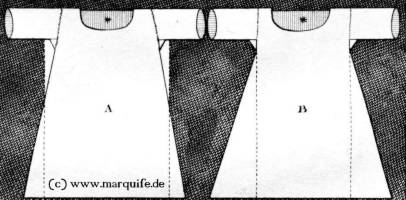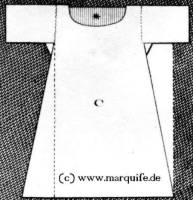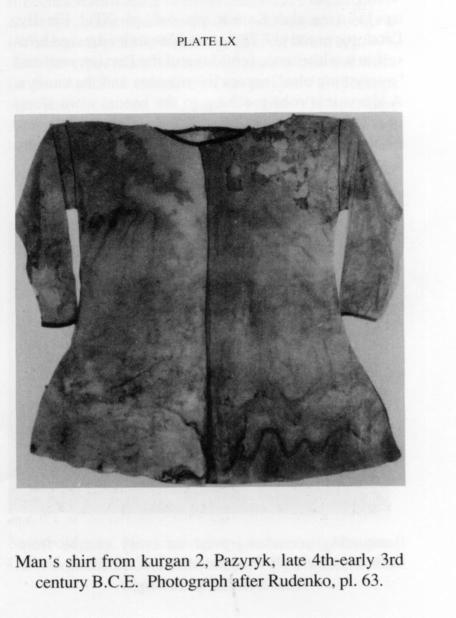Sean M wrote:Mac, is this painting by Domenico di Bartolo, Sienese (d. 1446) in your Pinterest? It shows breeches with an eliptical gusset between the legs.
Sorry I missed you post
That's a nice detail of a classic Type IV! I'll go pin that now.
Mac
Moderator: Glen K
Sean M wrote:Mac, is this painting by Domenico di Bartolo, Sienese (d. 1446) in your Pinterest? It shows breeches with an eliptical gusset between the legs.
tiredWeasel wrote:You already have on picture from the Karlsruhe Passion - but this one is also good for shirt related studies.
I focus mostly on the time around 1460 but in a HRE-context there are mostly two types of neck openings: the classic keyhole and a simple slit wide enough for the head to pass through and then folded once under the doublet (that type is also common in italian art and can be seen at least two times in the Karlsruhe Passion, in the link above it's the fellow in the middle with the red felt hat).
On a semi-related note: the linen version worked just fine. I will post about it as soon as I finished the second piece with a bias cut.
Thanks, guys!Sean M wrote:Don't forget BNF Nouvelle acquisition française 5243 Guiron le Courtois (painted 1370-1380, men's and women's shirts side by side!) http://manuscriptminiatures.com/4365/16843/
BNF Français 343 Quest del saint graal fol. 32 http://manuscriptminiatures.com/4317/7121/
ONB Cod. 2537 Roman de Tristan (c. 1410-1420) http://manuscriptminiatures.com/4935/14796/
BNF Français 357 vol. 83r http://manuscriptminiatures.com/5182/16309/ (c. 1420)
The Execution of Olivier de Clisson, BNF Français 2643 fol. 126 (painted 1470-1475) https://commons.wikimedia.org/wiki/File ... (1343).jpg





















That was my thought as well. It looks like the age of doublets ushers in a general shortening of shirts among the stylish. I wonder if that means that those noble fellows who are showing up at their executions with the "old fashioned" shirts have made a choice to do so, or whether the artists have just done them the favor of covering up their braies. In either case, I notice a sort of dichotomy between the high status guys who are executed in their shirts, and the villains who get offed in their braies allone.John Vernier wrote: I think as long as your hosen point to your braies the shirt can be long, just a bit shorter than the skirt of your tunic so it doesn't peek out. Once your hosen point to your doublet you need to be able to tuck your shirt tails into your hosen, so you want to keep the tails to a minimum. Excess shirt bulk wadded into tightly fitted hosen just looks like crap (though I suppose if done artfully it might be used to correct some deficiencies?).
Oh! Good call! I had not noticed the gathering at the back of the neck.John Vernier wrote:
However, if you just make the shirt wide and with a long horizontal shoulder slit, it will tend to fall off your shoulders. The Clisson execution scene hints at how this was made, with the excess width gathered in the back but not the front, thus defining the width of the shoulders and leaving the front of the slit effectively longer than the back.




















I think you are right about that. If it were a vent, we should see flesh color there.Sean M wrote: I think the Tacuinum thresher has a gore in the bottom of the side seams of his shirt, the line of the bottom of the shirt runs straight across the breeches.







That's very true. But it's also easy to underestimate our ancestors. These are both things to guard against.tiredWeasel wrote: It's easy to overthink this.



Good stuff! Thanks!Sean M wrote:Mac,
I am starting to see a Germanic tradition of shirts with an open front in the 15th century.
Christ bearing the cross 1415-1420 IMAREAL 013016
Christ and the captain of Kapharnaum 1425-1435 IMAREAL 005146
Trojan War 1445-1450 IMAREAL 006477
Martyrdom of St. George with Fire 1465-1470 IMAREAL 000570
I have not seen these anywhere outside Germany and Austria, so I would be very cautious about extrapolating to Italy, but they appear in the period and social status you are looking for.
Those are my thoughts as well. Those guys in the Boccacio even have collars on their shirts. I don't think we see this anywhere else till quite a bit later.John Vernier wrote:To me it seems clear that the St. Louis shirt is essentially cut like the tunic it would be worn under. Perhaps it is a less bulky version of that pattern, but the pattern is the same in concept - and that's a perfectly logical way to conceive a shirt, although it obviously isn't the way they were conceived in the 18th century. A lot of the 15th century drawings Mac has pulled up look to me like they are draped rather like skimpy versions of houppelandes. The folds fall in the same way, sometimes strikingly so, to a degree that I find a bit improbable:
Me tooJohn Vernier wrote:But never mind my doubts. I would love to see how close you can come to replicating this cut of shirt.
Almost anything will be an improvement on my current shirts. If I can be dashing while dashing, that just gravy.John Vernier wrote:I have no doubt you can make one which will cut a dashing figure on the way to the porta potties at Pennsic.
I'm not worried about tucking the hems into my braies. That's for guys who wear doublets and short outer garments with nice hosen. I think they would wear a short version of the shirt to begin with. I'm never going to wear anything but longish coats, so long shirts will be fine for me.John Vernier wrote:What I want to know is whether it will tuck conveniently into your braies with all that extra fullness.
That's certainly an interesting question. It looks like that shirt is on the road to the square shirts that come later. Someone (not me, I hope) needs to work on figuring out the history of shirts.John Vernier wrote:And we can address the question of when the square-cut shirt came into being separately. I think the Gnalic shipwreck shirts of c.1570 are a good place to start.
I believe this is the same shirt which Dorothy Burnham illustrates as the Zadar shirt on p.15 of Cut My Cote.
There is a cutting diagram as well, but it's too tall for me to post:
https://www.pinterest.com/pin/568016571730365420/





